
The digital age has transformed virtually every sector of human life, and healthcare is no exception. A crucial component of this digital revolution, specifically in the realm of marketing, is search engine optimization, or SEO.
Healthcare SEO, in particular, is gaining more attention due to its potent capacity to streamline healthcare services and products to a larger, targeted audience. Here, we delve into the world of Healthcare SEO and elucidate why it’s becoming an indispensable tool for healthcare marketers and organizations.
Healthcare SEO is a digital marketing strategy tailored specifically to the healthcare industry. It involves optimizing the websites of healthcare providers, medical practices, clinics, hospitals, pharmaceutical companies, and other health-related organizations to improve their visibility in search engine results.
Like standard SEO, Healthcare SEO involves several components, such as keyword research and optimization, link building, content creation, and website optimization.
However, what sets Healthcare SEO apart is its focus on healthcare-specific keywords, trends, and user search behaviors. It targets individuals actively seeking healthcare information, medical services, or products, ensuring that your healthcare services are visible and accessible to those who need them the most.
As we progressively inhabit a more digitized world, consumers are relying on the internet for their needs, including healthcare. This shift in behavior is making Healthcare SEO not just an advantageous strategy but a necessary one. The importance of this strategy can be better understood by analyzing key statistics and trends in healthcare searches.
Search Drives Traffic to Hospital Websites
Data from Google indicates that “search drives three times more visitors to hospital sites compared to non-search sources.”
(Source – Think with Google)
This figure underscores the pivotal role of SEO in directing this online traffic. Without optimized content, a healthcare provider’s site may not appear in these searches, missing out on potential visitors and, by extension, potential patients.
Patients Who Book Appointments Run More Searches
“Patients who booked healthcare appointments ran 3x more searches than those who didn’t.”
(Source – Think with Google)
This statistic shows that people actively searching and booking health services are relying heavily on search engines. Without Healthcare SEO, a provider might be invisible to these proactive patients, leading to missed opportunities.
High Volume of Health-related Searches
Google’s Health Vice President, David Feinberg, MD, stated that “approximately 7 percent of Google’s daily searches are health-related. With over 70,000 search queries every minute, this amounts to over a billion health-related searches daily”.
(Source – The Telegraph)
The sheer volume of these searches underscores the high demand for health-related content online. Absence of SEO strategies could mean that a healthcare provider’s valuable services are being drowned in a sea of unoptimized content, inaccessible to those who are actively looking for such information.
These statistics demonstrate a consistent and increasing demand for health-related information and services online. As a result, healthcare providers need to employ SEO tactics to optimize their online presence and content.
So, without further ado, let’s dive deeper into the 8 Core Healthcare SEO Pillars that can help your healthcare organization rank on the first page of search engines.’]
Before we delve into more complex strategies, we must first ensure that the foundation of our healthcare SEO is robust. This first pillar is all about building a strong website infrastructure that complies with SEO basics.
With the ever-increasing usage of smartphones for internet access, search engines like Google prioritize websites that perform well on mobile devices. Mobile-first design ensures that your healthcare website is mobile-friendly and can deliver an optimal experience to users, regardless of the device they are using.
A responsive design that adapts to different screen sizes, easy navigation, and fast load times are all part of a mobile-first design.
A slow-loading website can be a major deterrent for users. In fact, a delay of just a few seconds can significantly increase the bounce rate. Google and other search engines consider site speed as a ranking factor, so it’s essential to optimize your website’s speed.
This can be achieved by minimizing HTTP requests, enabling compression, reducing server response time, and optimizing images and other media files.
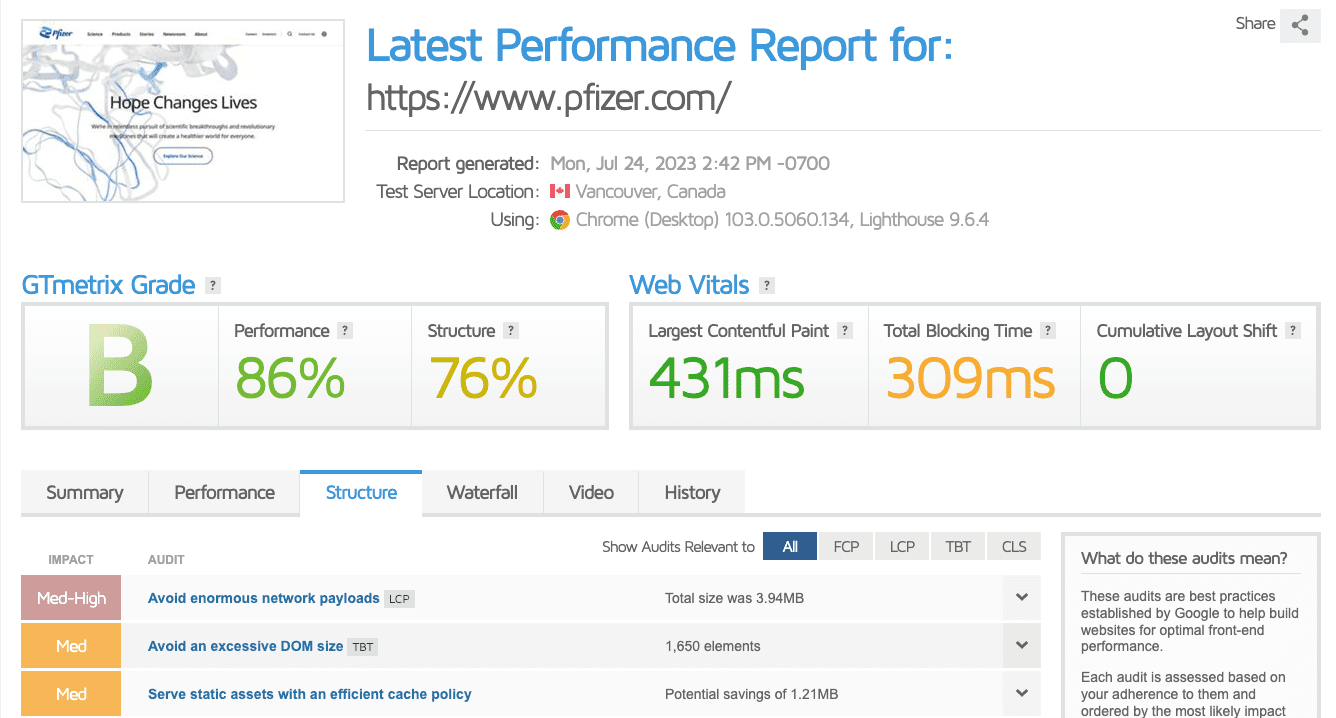
We recommend using GTMetrix to run a quick speed test of your website.
Security is a top concern for users, especially when they are dealing with sensitive health information. Google has declared HTTPS as a ranking signal, meaning websites with HTTPS are favored over those without.
HTTPS provides a secure connection for your visitors, protecting their information and instilling trust.
If you haven’t already, consider migrating your website from HTTP to HTTPS.
User-friendly URLs, or ‘clean’ URLs, are simple to read and describe the page’s content. This makes them helpful for users and search engines alike. For SEO, best practices include using keywords where appropriate, using hyphens to separate words, and keeping URLs as short as possible.
For instance, a URL like “www.yourwebsite.com/heart-health-tips” is preferred over “www.yourwebsite.com/post12345”.
An XML sitemap acts as a roadmap of your website that helps search engines find, crawl and index all of your website’s content. It’s especially important for large websites, new websites, or websites with numerous high-quality pages that aren’t properly linked.
Creating and submitting an XML sitemap to search engines can enhance your website’s visibility and improve its SEO performance.
Robots.txt files guide search engine bots on which parts of your website they should or shouldn’t crawl, helping to use your site’s crawl budget effectively. This can prevent search engines from crawling unimportant or similar pages on your website, ensuring that the most important content is crawled and indexed.
Always ensure your robots.txt file is properly configured to avoid accidentally blocking search engines from valuable content.
The second pillar of Healthcare SEO revolves around keyword research, the cornerstone of any successful SEO strategy. Proper keyword research involves understanding and utilizing the right set of keywords that potential patients use in search engines when looking for healthcare services, symptoms, or treatments.
Service-based keywords are directly related to the healthcare services that your organization offers.
These could range from:
Identifying the right service-based keywords ensures your website appears in search results when prospective patients are searching for these specific services.
Condition or symptom-based keywords are those that potential patients might use to understand their symptoms or learn more about a specific condition.
Examples Include:
Ranking for these keywords helps position your healthcare organization as a trusted source of information, attracting potential patients in their moment of need.
Did you know?
“66% of Internet users look online for information about a specific disease or medical problem.”
(Source- Pew Research)
Geo-targeted keywords combine healthcare services with a specific geographic location. These could be as broad as a country or as specific as a neighborhood.
For instance:
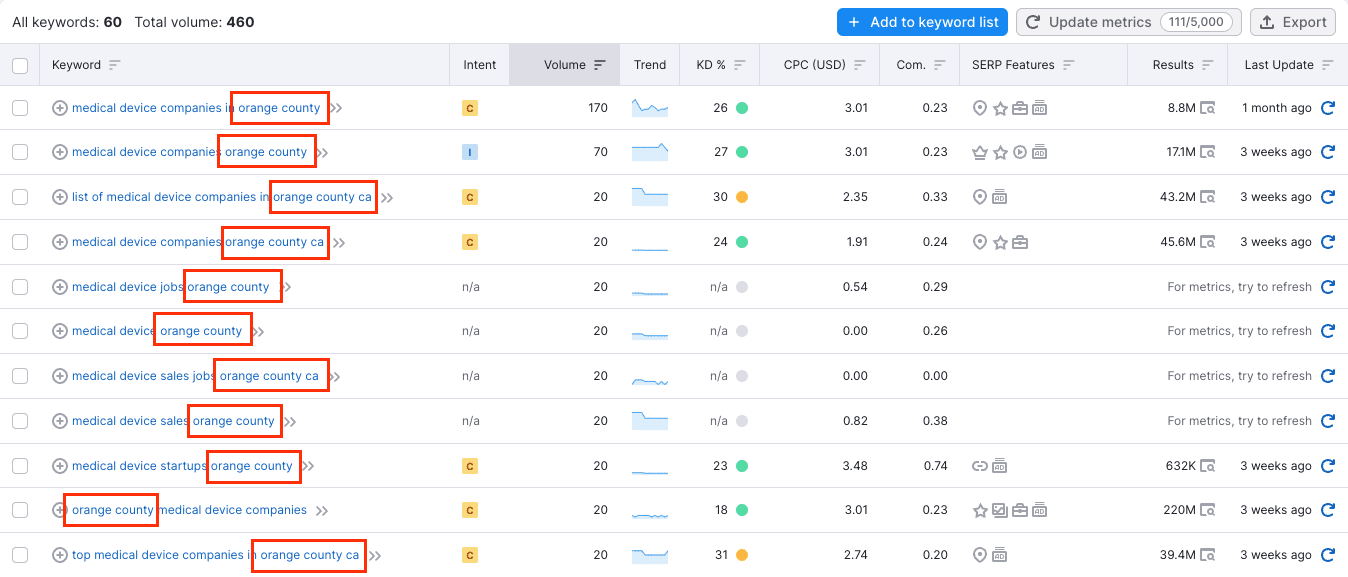
Optimizing for geo-targeted keywords ensures your website is found by potential patients in your local area or service radius.
Did you know?
“’Near me’ searches for healthcare services have doubled since 2015.”
(Source- Think with Google)
Long-tail keywords are more specific, longer phrases that potential patients might search for. Although they have lower search volumes compared to shorter, more generic keywords, they usually have higher conversion rates as they are more specific.
Examples Include:
Ranking for these keywords can help your organization attract more qualified leads.
LSI keywords are semantically related to your main keyword. They help search engines understand the context and content of your webpage, improving your chances of ranking higher in search results.
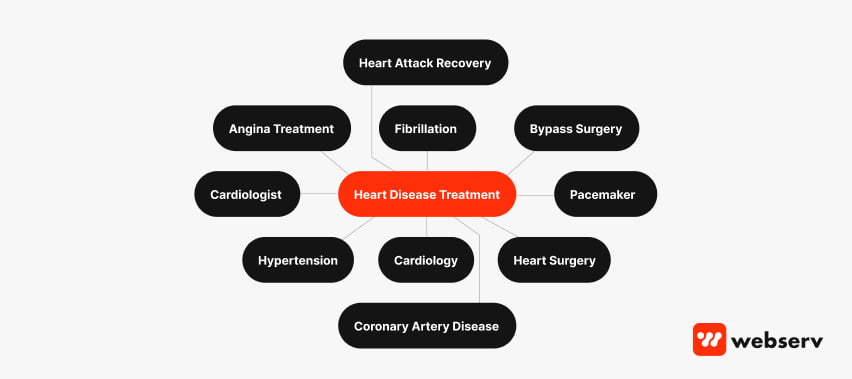
For instance, if your main keyword is “heart disease treatment”, LSI keywords might include “cardiologist ”, “heart surgery ”, “cardiovascular health ”, “heart disease symptoms ”, and “heart disease prevention ”.
The third pillar of Healthcare SEO is On-Page SEO, a set of optimization techniques applied directly to your website to improve its search engine visibility and user experience. It ranges from optimizing meta tags and images to creating and optimizing high-quality content, implementing schema markup, and establishing a robust internal linking system.
Meta tags provide search engines with information about your webpage’s content. They can influence your website’s search engine rankings and click-through rates.
Title Tags: Title tags define a webpage’s title and appear in the search engine’s results pages (SERPs). Each of your web pages should have a unique title tag, ideally incorporating the page’s primary keyword.
Meta Descriptions: Meta descriptions provide a brief summary of a webpage and appear beneath the title tag on SERPs. While they don’t directly influence rankings, compelling meta descriptions can improve click-through rates.
Header Tags (H1, H2, H3, H4, H5, H6): Header tags structure your content, making it easier for users and search engines to navigate your page. The H1 tag typically includes the main title or the most important keyword, while the rest of the headers (H2-H6) structure your content in a hierarchical order.
Proper image optimization plays a key role in creating a smooth, engaging user experience and boosting your site’s SEO performance. It mainly involves the use of ALT tags and image compression.
ALT tags, or alternative text descriptions, help search engines understand the content of an image. This is particularly vital because search engines can’t “see” images the way humans do; they rely on ALT tags to interpret them.
Try to incorporate relevant keywords in your ALT tags, but remember to keep them accurate and descriptive.
Image compression addresses the challenge of large image file sizes slowing down your website. By compressing your images, you can significantly reduce their file size without notably compromising their quality.
This leads to faster page load times, enhancing the overall user experience, and indirectly boosting your SEO performance as search engines favor speedy websites.
Creating high-quality, optimized content is key to your website’s SEO performance and user engagement. Consider the following types of content:
With healthcare-specific content creation, the accuracy and reliability of information are paramount. By engaging members of your clinical team to review and validate your content, you ensure that every piece of information adheres to the highest standards of medical accuracy. This practice not only instills confidence in your audience but also signals to search engines the credibility and trustworthiness of your content, providing a dual benefit that is essential.
Schema markup is a form of microdata that helps search engines better understand your website’s content, improving your visibility on SERPs. For healthcare organizations, relevant schema types could include MedicalWebPage, MedicalClinic, and Physician.
Internal linking refers to linking one page of your website to another page on the same website. It helps distribute page authority throughout your site and enables users and search engines to navigate your website more easily. Make sure to use descriptive anchor text for your internal links.
The fourth pillar of Healthcare SEO is Off-Page SEO. Unlike On-Page SEO, Off-Page SEO involves strategies outside your website to improve your website’s visibility, reputation, and trustworthiness. This pillar includes backlink building, local SEO, and managing reviews and ratings.
Backlink building serves as one of the key strategies for SEO. Backlinks, also known as inbound links, are essentially votes of confidence from other websites. These links signal to search engines that your content is reliable, valuable, and trustworthy, which, in turn, boosts your website’s visibility and authority.
One prominent strategy for backlink building is guest posting. This approach involves producing high-quality, valuable content for other reputable websites within your industry.
The dual-faceted benefits of guest posts cannot be overlooked. Not only does the host website receive relevant and engaging content, but you also get a golden opportunity to link back to your site, either within your bio or judiciously placed within the content.
Another effective method to procure high-quality backlinks involves forming strategic partnerships with medical institutions. Joint research, reciprocal guest blogging, or resource exchange are some means to foster such partnerships.
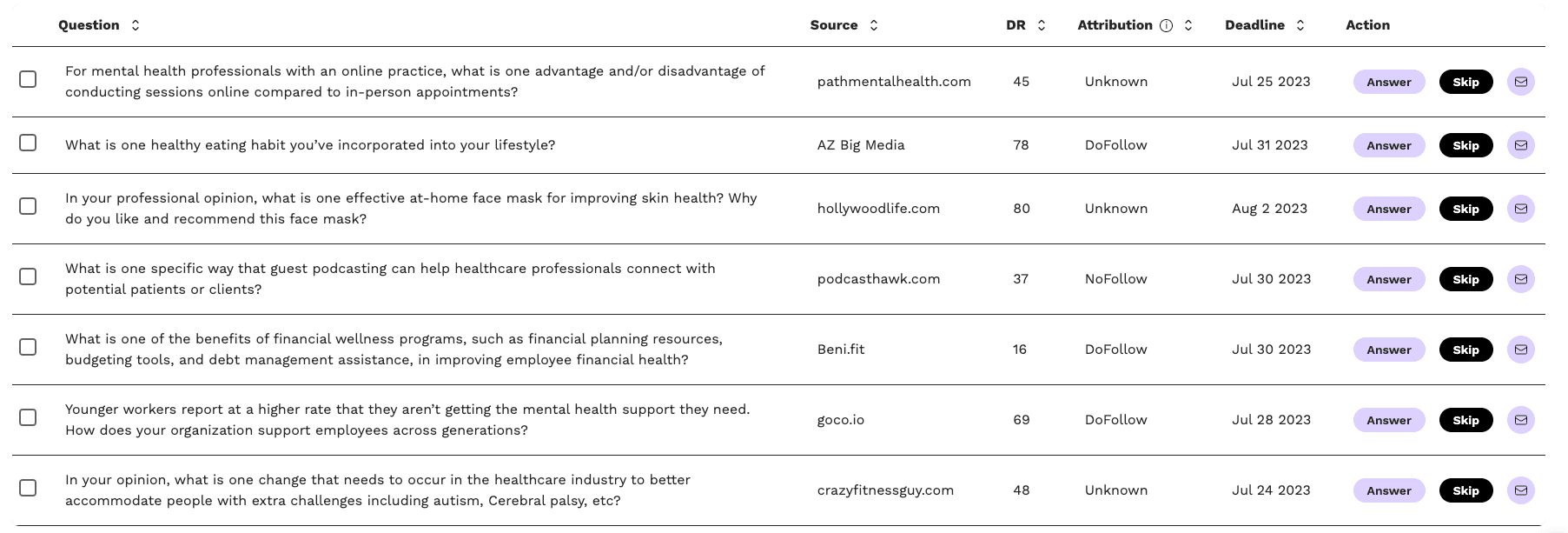
In addition, platforms such as Featured.com and Connectively.us serve as valuable avenues to showcase your healthcare expertise and experiences. They offer diverse opportunities, like participating in expert roundups, providing insightful commentary, or contributing to collaborative articles.
Local SEO is a powerful tool for healthcare providers as it targets potential patients in your immediate vicinity. In our opinion, Local SEO is one of those low hanging fruits that can provide a significant boost in calls and website traffic.
Google My Business (GMB):
GMB is a free tool that lets you manage how your business appears on Google Search and Maps. Let’s check out the steps to claim your GMB listing.
Step 1: Go to the GMB website and click on “Manage Now.”
Step 2: Sign in with your Google account or create a new one if you don’t have one already.
Step 3: Enter your business name. If it appears in the dropdown menu, select it. If not, click on “Add your business to Google.”
Step 4: Choose the appropriate category for your business.
Step 5: Enter your business location and phone number.
Step 6: Select a verification method and follow the prompts. You can verify immediately by phone or email, or receive a postcard at your business address within a few days.
Step 7: Once verified, fill in your profile with as much detail as possible. Include your hours of operation, services, photos, and any other relevant information.
Remember to keep your information up-to-date, and actively manage your listing by responding to reviews and posting regular updates.
2. Bing Places for Business:
Similar to GMB, Bing Places for Business allows you to create and manage your business listing on Bing. The claiming process is similar to GMB. Consistency across multiple platforms is crucial, so ensure your information matches that provided on GMB.
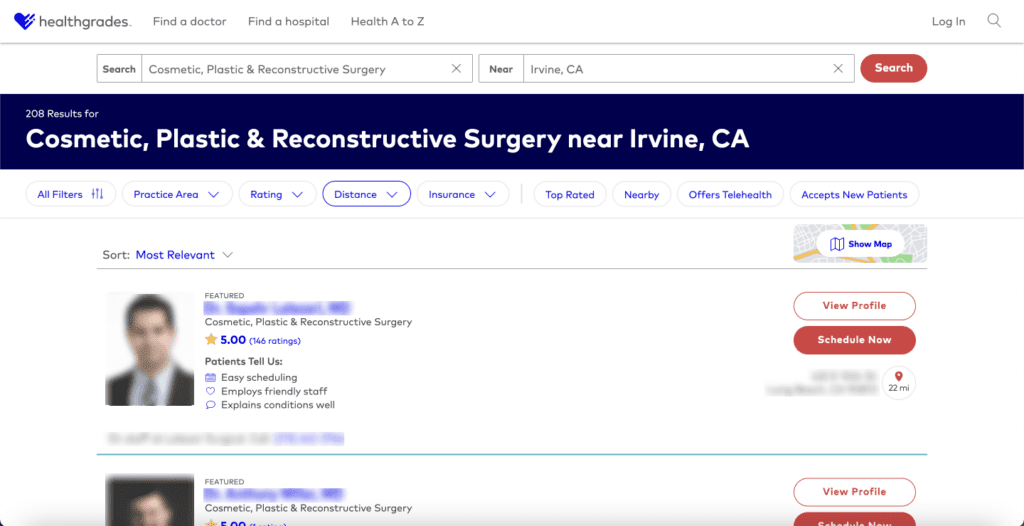
3. Niche-Specific Directories:
Being listed in healthcare-specific directories can greatly enhance your local visibility. Examples of such directories include Healthgrades, Zocdoc, RateMDs, and MedlinePlus. To be listed, visit each directory’s website and follow their specific process, usually involving creating an account and verifying your business details.
Our innovative approach to Local SEO has earned us recognition from industry leaders. SEMRush, a top-tier SEO tool, recently highlighted our outstanding performance in their in-depth video review. They examined how we’ve mastered local search results to connect more patients with our healthcare clients.
For a closer look, check out the SEMRush video below:
Online reviews and ratings have a significant impact on your online reputation. Encourage satisfied patients to leave positive reviews on platforms like Google My Business and Yelp, as these reviews can influence potential patients’ decision-making process.
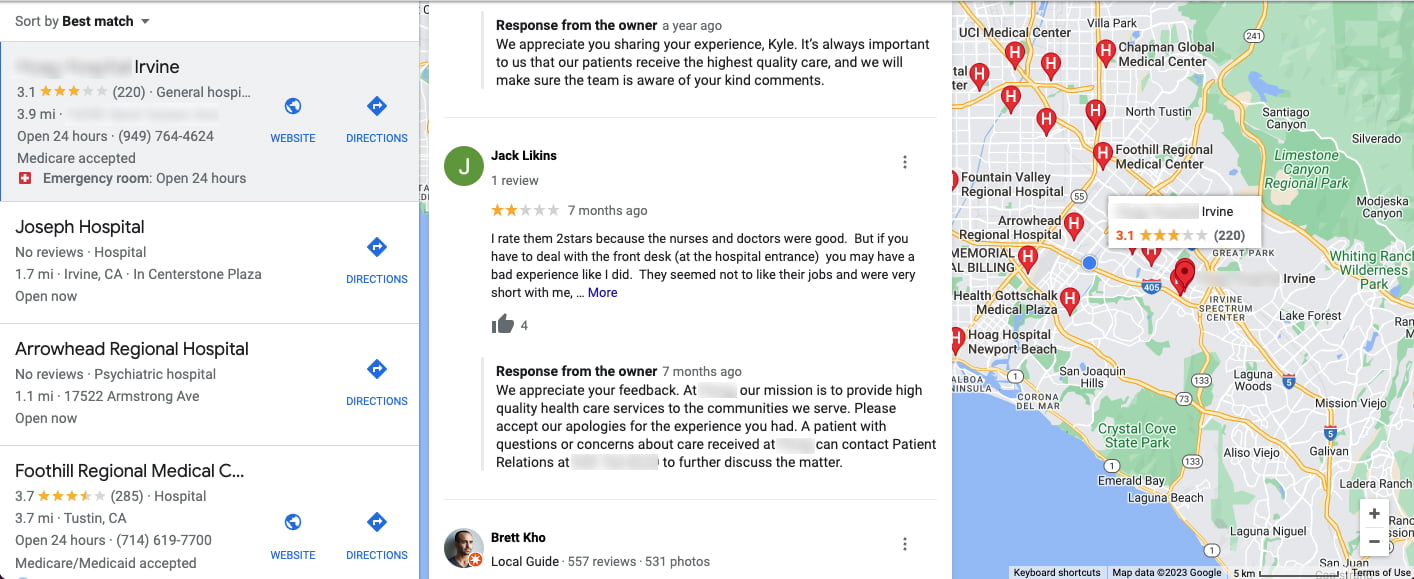
Did you know?
“91 percent of people regularly or occasionally read online reviews, and 84 percent trust online reviews as much as a personal recommendation. And they make that decision quickly: 68 percent form an opinion after reading between one and six online reviews.”
(Source- Bright Local)
Technical SEO is the foundation of your entire SEO strategy. It involves optimizing your website structure and the backend environment so that search engines can crawl and index your website more effectively. Let’s delve into the key aspects of Technical SEO:
Canonicalization is the process of selecting the best URL when there are several choices. For example, your homepage could be accessed via both “http://www.yoursite.com” and “http://yoursite.com“.
By setting a canonical URL, you tell search engines which version to index. This is crucial for preventing duplicate content issues, which could dilute your site’s value in the eyes of search engines.
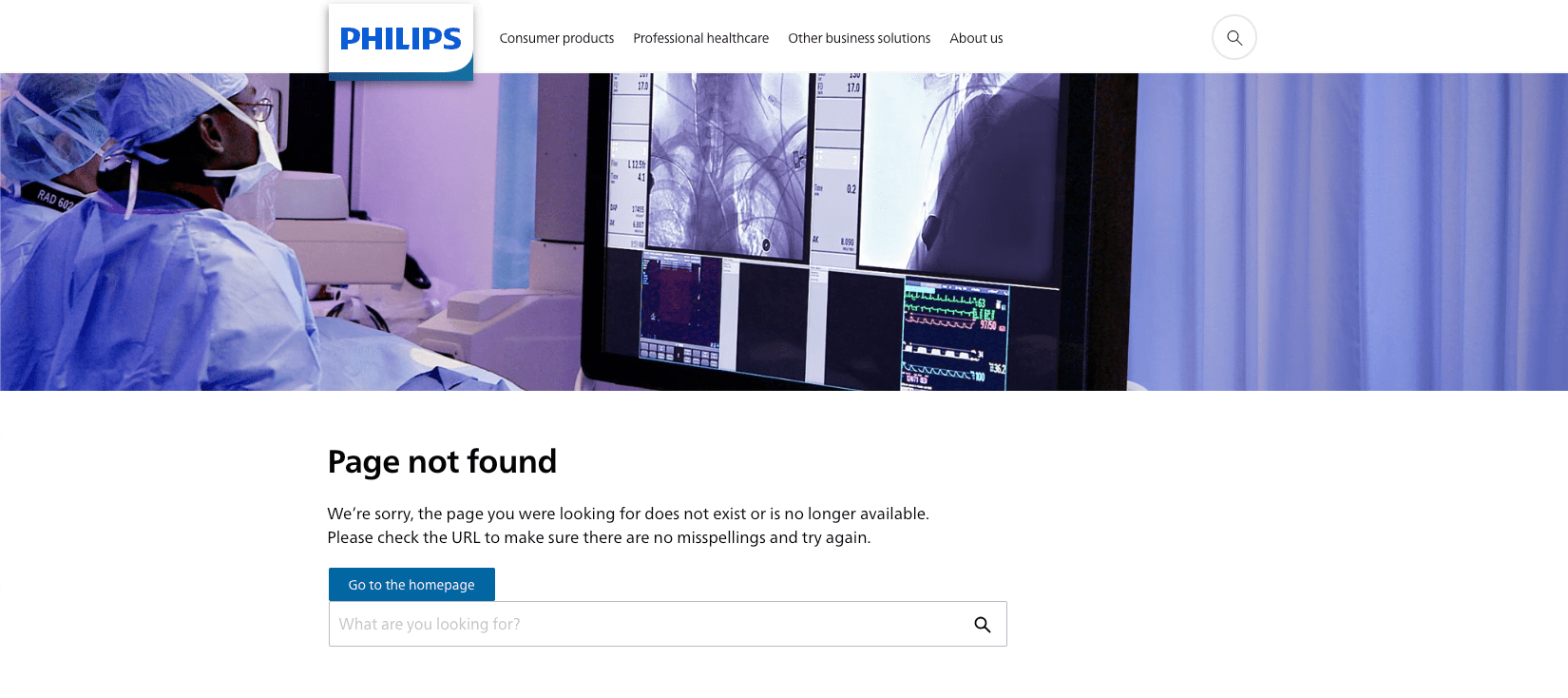
404 errors occur when a page on your website can’t be found. This often happens when a page is removed or the URL is changed.
Regularly auditing your website for 404 errors and setting up 301 redirects to the most relevant page can enhance user experience and maintain the link equity passed from other sites.
With the prevalence of mobile search, having a mobile-friendly website is no longer optional—it’s a necessity. This means your website should be easy to use on a variety of mobile devices, with buttons, menus, and forms that can be easily navigated on a smaller screen.
Additionally, the mobile version of your site should load quickly, as site speed is a crucial ranking factor for Google’s mobile-first index.
A logical, clean website structure makes it easier for search engines to crawl your site, and for users to find the information they need.
Breadcrumbs, which are a secondary navigation scheme, can aid users in understanding their location within your site’s hierarchy. They also provide search engines with another clue to your site’s structure.
Core Web Vitals are a set of metrics that Google considers important for evaluating user experience, including loading time (Largest Contentful Paint), interactivity (First Input Delay), and visual stability (Cumulative Layout Shift).
These metrics are becoming increasingly important for ranking, so it’s crucial to continuously monitor and optimize your website’s performance in these areas.
SEO Analytics and Reporting are critical for monitoring your website’s performance, understanding your audience, and improving your strategy. These practices involve using specialized tools and reports to analyze the effectiveness of your SEO efforts.
Google Analytics is a comprehensive tool that allows you to track a wide range of metrics related to your website traffic, user behavior, and conversions.
With this data, you can understand where your visitors are coming from, how they interact with your site, and which pages or posts are most popular. It’s vital to regularly review these metrics to gain insights and make data-driven decisions about your healthcare SEO strategy.

Search Console is another valuable tool provided by Google. It provides insights into how Google views your website, helping you understand your site’s performance in organic search results.
You can monitor indexation issues, submit sitemaps, and see which keywords your site ranks for.
Understanding how users interact with your website can provide invaluable insights into improving user experience and increasing conversion rates. Tools like heat maps and session recordings can reveal usability issues and show which parts of your site are most engaging. A particularly useful tool for this kind of analysis is Microsoft Clarity.
Microsoft Clarity is a free user behavior analytics tool that helps you understand how users are interacting with your website. It provides heat maps, session replays, and an insights dashboard that surfaces interesting user behavior trends.
With Clarity, you can identify areas of friction on your site, understand user actions, and make data-driven decisions to optimize your website.
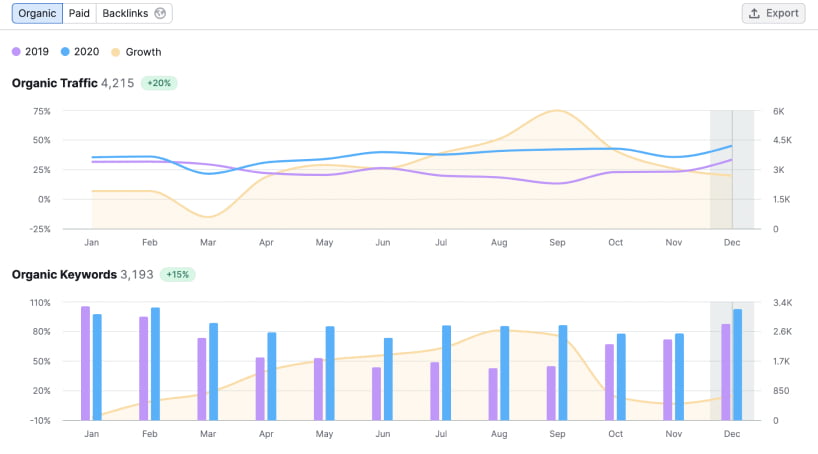
Monitoring your keyword ranking and analyzing your organic traffic are key tasks in evaluating the effectiveness of your SEO efforts.
Keyword ranking involves tracking the position of your targeted keywords in search engine results over time. Regular keyword ranking reports can help you understand the progress of your SEO strategies and adjust them as necessary.
Simultaneously, it’s vital to analyze your organic traffic—the visitors who find your site through search engine results. A rise in organic traffic is a good indication that your SEO efforts are paying off and that your website’s visibility is improving.
We recommend tools like SEMRush, Ahrefs, and Moz Pro which can provide detailed reports on both your keyword rankings and organic traffic, helping you fine-tune your strategy and maximize your online presence.
Limited Resources? We’ve Got You Covered
Is a lack of in-house capabilities or resources hindering your marketing efforts? That’s where we step in. As a specialized healthcare marketing agency, we seamlessly integrate with your team, helping you overcome these challenges.
Adaptability is the cornerstone of a successful SEO strategy. Search engine algorithms are constantly evolving, and healthcare marketers must stay reactive to these changes and ensure compliance with all guidelines to maintain strong online visibility.
SEO algorithm updates play a major role in how your website ranks on search engine results pages (SERPs). Google, in particular, frequently releases updates that can significantly impact your website’s rankings. Understanding and quickly adapting to these updates is crucial for sustained SEO success.
Google Broad Core Updates: These updates typically involve significant changes to Google’s ranking algorithm and can affect a wide range of websites across different industries. Staying updated about these broad core updates can help you make necessary changes to your SEO strategy.
Specific Algorithm Updates: Over the years, Google has rolled out specific algorithm updates targeted at particular aspects of SEO, such as content quality (Panda), link quality (Penguin), and health and medical information (Medic). Keeping track of these updates and adjusting your strategies accordingly is vital for maintaining your website’s ranking.
Compliance with search engine policies is non-negotiable. Two important aspects that healthcare websites need to consider are Google’s E-E-A-T (Experience, Expertise, Authority, Trustworthiness) guidelines and YMYL (Your Money or Your Life) pages.
Google’s E-E-A-T Guidelines: Given the sensitive nature of healthcare information, Google emphasizes the importance of E-E-A-T for medical websites. Ensuring your website reflects high levels of experience, expertise, authority, and trustworthiness can significantly improve your ranking.
YMYL Pages: These pages contain information that could impact a person’s health, financial stability, or safety. Google holds YMYL pages to the highest standards, and healthcare websites must ensure the information provided on these pages is accurate, comprehensive, and backed by reliable sources.
Effective SEO isn’t static—it’s a dynamic process that requires constant adaptation to shifting trends in search behavior. One key aspect of this is staying attuned to seasonal trends. Certain health conditions can see their search volumes fluctuate throughout the year.
By monitoring these trends, healthcare marketers can fine-tune their content strategy to better align with the changing needs and interests of their audience.
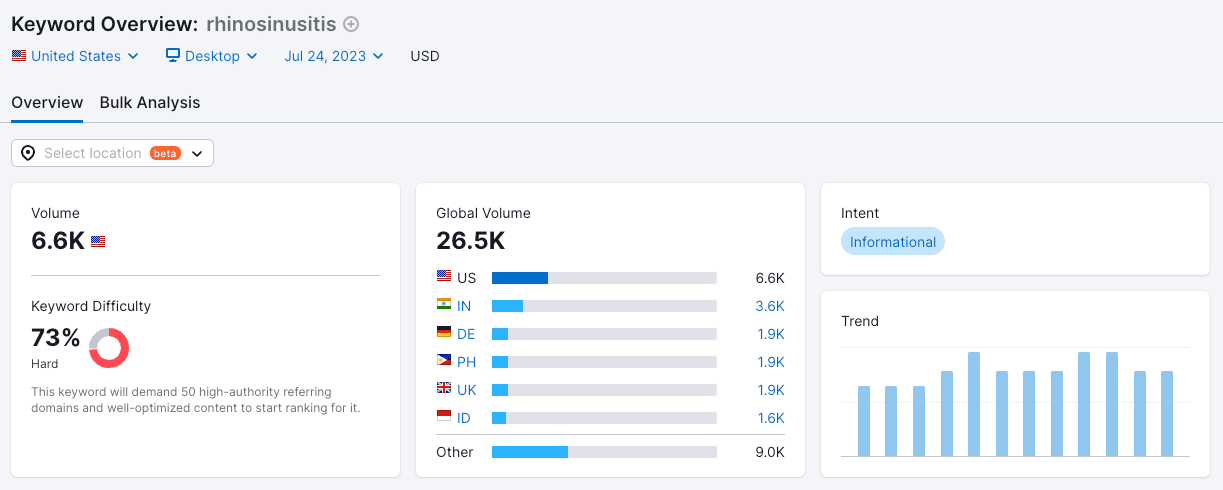
Did you know?
“Over a 15-year period, Google searches with rhinosinusitis-specific search terms consistently peaked during the winter around the world.”
(Source- NCBI)
Building trust in the healthcare sector is as much about visual assurance as it is about the quality of information and care provided. When potential patients visit a healthcare website, they’re often looking for signs that can help ease the anxiety that comes with healthcare decisions. Showcasing your staff and facility through photos is a key strategy in creating a comforting online presence.
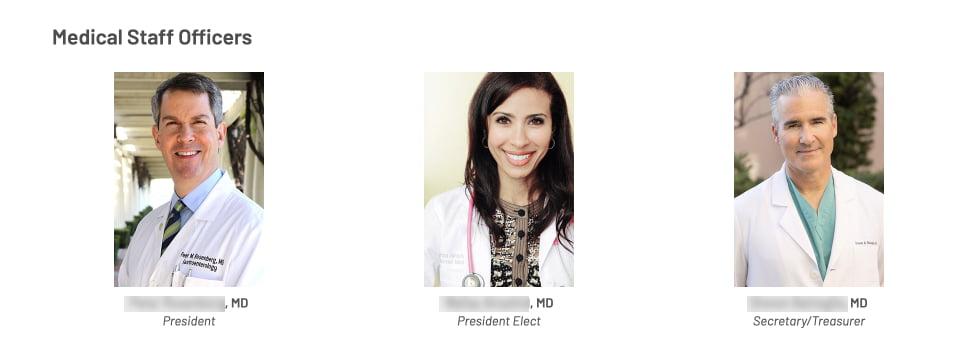
Having a dedicated section on your website for staff profiles with their most recent photographs allows patients to see the faces behind the care they will receive. Including their qualifications, areas of expertise, and professional achievements brings a level of validation and assurance that is critical in healthcare. It’s also beneficial to share a bit about their personal journeys or passions related to healthcare, as it adds a relatable and humanizing dimension to their professional profiles.
Credentials are not just certificates; they are badges of trust and capability. Displaying the accreditations, certifications, and educational qualifications of your medical staff can reassure patients that they are in competent hands. Highlighting ongoing education and training can also show commitment to staying current in medical practice.
Inviting potential patients to take a virtual tour of your healthcare facilities can be incredibly effective. Photos that display different areas of the facility help set the right expectations. Showing images of a welcoming reception, well-equipped treatment rooms, and comfortable patient areas provides a preview that can help calm the nerves of future visitors.
With health and safety being paramount, photos that showcase your facility’s commitment to these aspects are reassuring. Clean, orderly, and technologically advanced settings can be very appealing. Additionally, highlighting any specific areas designed for patient privacy and comfort can foster a sense of security.
Adding to the personal touch, images and stories from satisfied patients can make a profound connection with prospective ones. When they see others who have had positive experiences, it helps validate their choice. Moreover, photos capturing moments of care and attention between staff and patients speak volumes about the level of compassion they can expect.
By weaving these visual elements seamlessly into your SEO strategy, you can provide a more reassuring and trustworthy experience for site visitors. This not only improves the chances of converting site visits into appointments but also establishes a foundation of trust before patients step through your doors.
SEO is not a one-off task but a continual commitment. Just like healthcare itself, it requires regular check-ups, careful diagnosis, and a proactive approach towards change and adaptation.
By following these 8 Core Pillars, healthcare marketers and healthcare organizations can create a robust SEO strategy that drives traffic, builds authority, and supports long-term growth.
Embrace the journey of SEO – it’s an investment in your online future, offering returns that can reshape your organization’s reach and influence.
Maximize Your SEO Potential
Consider us an extension of your marketing team. We bring SEO expertise that ensures your site not only ranks high but also connects meaningfully with patients and drives quality traffic. This isn’t about just participating in the SEO game – it’s about leading it.
[Updated Nov. 6th, 2023]
Healthcare SEO is the practice of optimizing a website to improve visibility and ranking in search engine results pages, specifically for health-related topics. It involves utilizing techniques such as keyword research, content optimization, link building and other tactics to help potential patients find specific healthcare related information more easily.
Healthcare SEO helps bring organic traffic to your medical website that can be converted into qualified leads and eventually new patients. By creating content that is optimized for search engines, you can increase your visibility in search engine results pages and attract more visitors who are interested in the services or products that you offer. Additionally, it can improve brand awareness, build trust with potential customers, and target audiences with specific needs who may not know about your business yet.
Some essential best practices for healthcare SEO include using relevant keywords throughout content and titles; creating high-quality, informative content; leveraging local citations; investing in an optimized website design; optimizing images with keywords; creating backlinks from external sources; regularly monitoring website performance and adjusting strategies accordingly; staying up-to-date on industry news and trends; understanding user intent when crafting content; and keeping page speed in check.
Measuring the success of healthcare SEO is key to optimizing campaigns and improving results. Some effective metrics to monitor include organic traffic, backlinks from external sources, rankings for target keywords, conversions from organic search, and changes in overall visibility on search engine result pages.
Yes, healthcare SEO does require a long-term commitment as it takes time to see results from an optimization campaign. It’s important to have patience and consistency when it comes to SEO efforts and to continue building on strategies that are working well for you so that you can increase your website’s visibility and ranking over time.
